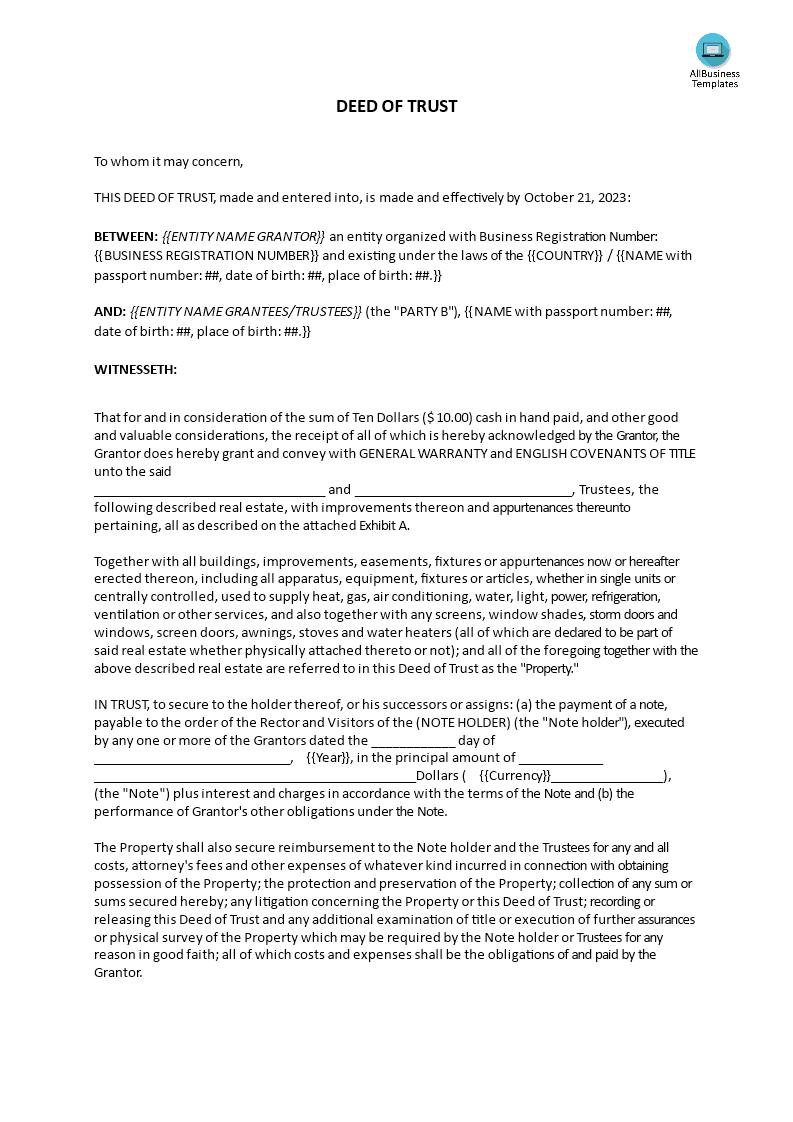Deed Of Trust Form
Save, fill-In The Blanks, Print, Done!

Download Deed Of Trust Form
Today: USD 3.99
Download It Now

Available premium file formats:
Microsoft Word (.docx)- This Document Has Been Certified by a Professional
- 100% customizable
- This is a digital download (28.54 kB)
- Language: English
- You will receive a link to download the file as soon as your payment goes through.
- We recommend downloading this file onto your computer.
How do you make a trust deed document? What are the steps involved? Our deed of trust form template is comprehensive and easy to use. It's perfect for those looking for a reliable document to use when entering into a trust agreement. Download this Deed Of Trust Form template now!
A deed of trust form, also known as a trust deed or a deed of trust and assignment of rents, is a legal document used in real estate transactions in some U.S. states. It is a critical component of the process when a borrower is obtaining a real estate loan or mortgage to purchase property. The deed of trust form serves as a security instrument, outlining the terms and conditions under which the lender (often a financial institution like a bank) can secure the loan with the property being purchased.
Here are the key elements and roles involved in a deed of trust:
- Parties Involved:
- Trustor: The borrower or property owner who is obtaining the loan and transferring the property's title into a trust.
- Beneficiary: The lender, typically a financial institution or lender who provides the loan funds to the trustor.
- Trustee: A neutral third party, often a title company or escrow agent, responsible for holding legal title to the property on behalf of the beneficiary and handling the foreclosure process if necessary.
- Property Description: The deed of trust specifies the property being used as collateral for the loan. This includes details like the property's legal description, address, and parcel number.
- Loan Terms and Amount: It outlines the terms and conditions of the loan, including the loan amount, interest rate, repayment schedule, and any other specific terms negotiated between the borrower and lender.
- Security Interest: The document establishes a security interest in the property, effectively granting the lender a lien on the property as collateral for the loan. This lien gives the lender the legal right to take possession of the property in case of loan default.
- Power of Sale Clause: Many deeds of trust include a "power of sale" clause, which gives the trustee the authority to sell the property through a non-judicial foreclosure process if the borrower defaults on the loan.
- Assignment of Rents: In some cases, the deed of trust may include an assignment of rents provision, allowing the lender to collect rental income from the property in the event of default.
- Covenants and Agreements: The document may contain covenants and agreements that the borrower must adhere to during the term of the loan, such as maintaining the property, paying property taxes, and keeping insurance coverage.
- Notary Acknowledgment: The deed of trust typically requires notarization to verify the authenticity of the signatures.
It's important to note that the specific content and requirements of a deed of trust form can vary from state to state in the United States, as different states have different real estate laws and regulations. Additionally, not all states use deeds of trust; some use mortgages instead.
Download this legal Deed Of Trust Form if you find yourself in this situation and save yourself time, and effort and possibly reduce the lawyer fees! Using our legal templates will help you to deal with the situation!
DISCLAIMER
Nothing on this site shall be considered legal advice and no attorney-client relationship is established.
Leave a Reply. If you have any questions or remarks, feel free to post them below.
Related templates
Latest templates
Latest topics
- GDPR Compliance Templates
What do you need to become GDPR compliant? Are you looking for useful GDPR document templates to make you compliant? All these compliance documents will be available to download instantly... - Google Docs Templates
How to create documents in Google Docs? We provide Google Docs compatible template and these are the reasons why it's useful to work with Google Docs... - IT Security Standards Kit
What are IT Security Standards? Check out our collection of this newly updated IT Security Kit Standard templates, including policies, controls, processes, checklists, procedures and other documents. - Letter Format
How to format a letter? Here is a brief overview of common letter formats and templates in USA and UK and get inspirited immediately! - Google Sheets Templates
How to work with Google Sheets templates? Where to download useful Google Sheets templates? Check out our samples here.
cheese
